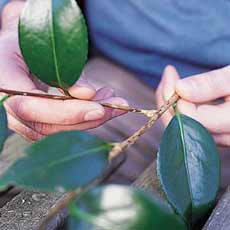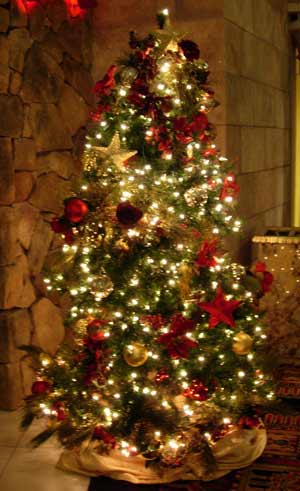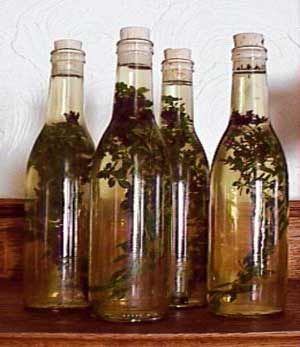December Top Tips For Your Limousin Garden


With December
December a peaceful cordial time for the gardener to relax and reflect! Don’t you believe it, as it could leave you with too much humbug and not enough punch?
November has past and the weather has been kind and if like us, you are still left with your summer roses still blooming make the most of them as December arrives.
December heralds the arrival of winter in about 3 week’s time, not a pleasant thought after the summer we have just been blessed with. Though, on the bright side literally, the winter solstice around the 21st – 23rd, means the nights start to claw back a little more light every day and before long hopefully, winter will be long forgotten.
With December’s entrance the gardener is left with a number of choices. The easy choice is to put your feet up and relax, why not it’s been a long hot year!
But, just when the rain has begun to abate, remember that you will have a small window of opportunity to either catch up or perform a couple of planting task’s before the temperatures will begin to fall and the ground will start to freeze.
At this time of year and the remainder of the winter, the two main areas of focus are on the protection/maintenance and planning/preparation of your garden.
Planting:
 Consider taking root cuttings of woody shrubs and evergreens, such as azaleas, holly and hydrangea, as this is the time of year to do so.
Consider taking root cuttings of woody shrubs and evergreens, such as azaleas, holly and hydrangea, as this is the time of year to do so.
Take hardwood cuttings from deciduous trees and shrubs. Dip the cut stems in a rooting hormone powder, then
plant in equal parts of sand and vermiculite. Remember to keep moist.
Bare-root season begins late on this month, so be on the look out for Peonies (the early ones).
For the fruit and vegetable gardener, cane berries, grapes and perennials such as artichokes, asparagus and rhubarb, are all worth considering.
Protection:
 Keep an eye out for where areas of your garden are prone to excessive water retention; most people don’t like their garden turning into a bog. Very important for the vegetable gardener, as too much water can be just as harmful as too little, as most will already know.
Keep an eye out for where areas of your garden are prone to excessive water retention; most people don’t like their garden turning into a bog. Very important for the vegetable gardener, as too much water can be just as harmful as too little, as most will already know.
If you have taken a chance and purchased new trees and shrubs, that normally like a more temperate climate. Keep fleeces and blankets close at hand for the coming cold nights. You may also want to consider the following.
As the temps drop and just before the ground really firms up, you might want to give newly planted trees, shrubs, etc a little extra protection by digging a couple of centimetres down and placing a thin layer of polystyrene over the top of the roots. Ensure that there is still a good measure of soil between the top of the root and the polystyrene as you do not want your plant to be starved of water.
There are two schools of thought about the above, some may believe that leaving the plant with no protection will ’toughen it up’ over the winter will make it more resilient for future years.
Others believe that a little protection over the first few years allows the growth to acclimatise in a more natural manner and therefore making it more resilient for future years.
The choice is yours, though one thing is for sure. The Limousin does have a history of plummeting temperatures that can damage and kill the most established of items in your garden.
If you have not yet got hay to cover tubers such as lilies, you do not have much time to do so.
Maintenance:
 If your stored bulbs begin to shrivel, they are too dry. Put them in a container with potting medium, peat moss or sawdust to stop the loss of water.
If your stored bulbs begin to shrivel, they are too dry. Put them in a container with potting medium, peat moss or sawdust to stop the loss of water.
Continue with your garden clean up that you began last month.
If December is the time to prune certain items in your garden such as dormant fruit trees and shrubs, do it.
Cut back chrysanthemums to about 6 inches (15 cm) and remove dead leaves and stems from dormant perennials if not already done so.
Keep on top of your weeds and keep lawns free of debris.
Watch out for frost heave and apply mulch as and when required.
With mulching, remember to thoroughly mulch your azaleas, rhododendrons, camellias and laurel after the ground freezes. These types of plants prefer acidic materials, such as oak leaves and pine needles, though; any mixed dry leaves will do if oak and pine are not available.
Your lawn, if you feel you want to be one step ahead of the game and are prepared to gamble on the prospect of a very cold winter. You may want to perform a early ‘winter cut’. Wait until the ground dries up a little and that a heavy frost is not going to occur the same night or the day after the day you cut. Take your grass down to 3 inches, NO LOWER.
Indoor plants:
 Christmas time is arguably the time of year when the majority of flowers and indoor plants will be purchased and given as gifts.
Christmas time is arguably the time of year when the majority of flowers and indoor plants will be purchased and given as gifts.
Here are a few pointers that may help. The first item that usually arrives in our house is the Christmas tree.
Be it a ‘live’ or a ‘cut tree‘, they both need water. The cut tree needs water to make your life simpler. Firstly, by not dropping as many needles that stick in your feet as it ’dries out’.
Secondly, by giving the tree water, it reduces the risk of it turning into a 7ft roman candle (this usually occurs when you turn the fairy lights on and go off and get way laid at the ’punchbowl’). So this year, keep them away from fires and radiators and give them both PLENTY OF WATER and please remember, to try to minimise the length of time your live tree is indoors, thus ensuring it is kept healthy when returned to the minus 10 weather conditions outside (ever wondered why certain countries only put their trees up on Christmas eve?).
Hot on the heels of our very moist Christmas tree; arrives our Poinsettia. To prolong the life of a flowering poinsettia, keep it evenly moist and protect it from being chilled or
subjected to drafts. Keep it in full sunlight in a cool area.
Remember that some if not all the potted plants you receive as Christmas presents may not, or are not, meant to be kept as permanent house plants (Poinsettia’s included).
They have been grown and nurtured in a greenhouse and do not normally adapt well to the sudden change from greenhouse to the conditions in your home. So with this in mind, either find out as much as you can about the plant and do the best you can. Or, treat them like long-lasting cut flowers and enjoy them as long as possible, though sadly, be prepared to discard them when they become unattractive.
For the cacti lovers. If the buds drop and the stems shrivel on your Christmas cactus, look for root injury caused by dry soil.
Planning and preparation:
 Preparation, unless you are the well seasoned greenhouse grower or winter vegetable grower. This time of year can and does afford you a little bit of a rest if you want one, but not for too long. As now is a good time to get all your photo’s and garden diary off the shelf and commence your review of what has worked well in your garden this last year and what hasn’t. Allowing you therefore to begin your planning for next season.
Preparation, unless you are the well seasoned greenhouse grower or winter vegetable grower. This time of year can and does afford you a little bit of a rest if you want one, but not for too long. As now is a good time to get all your photo’s and garden diary off the shelf and commence your review of what has worked well in your garden this last year and what hasn’t. Allowing you therefore to begin your planning for next season.
One tip on planning that you may want to include for this time next year, is this one. Excessively wet areas in your garden that are prone to a lot of water all year round (even with the summer we have just had) usually end’s up getting left fallow. This is a pity as there is a plethora of plants that just love this type of condition. So start to examine how wet and where over the next year, then start to look at what you will want to grow there.
Alright it’s Christmas I here you say, so to close here are a couple of fun tips that will either be practical or a waste of time.
The herbs that you put in a pot and brought indoors to prolong their growth? You still have time to make herb vinegars, use some chives, shallots, garlic and any of the herbs on your windowsill. Use approximately 100grm of your fresh herb and edible bulb mix to one litre of wine vinegar. Allow the herbs to infuse for at least two weeks.
Ladies, stuck for the ideal present for that man in your life? Then problem solved, get him a tin of ‘Non stick’ cooking spray, other wise known as sprayable Teflon (shouldn’t be to hard to find as it was invented by Tefal). Then on Christmas morning, banish him to the shed and get him to clean and then spray his favourite shovel with the Teflon (ensuring he wears a suitable mask when spraying). Why I here you cry!!! All will become clear when the snow falls; hubby will have a shovel that will allow him to clear a path a lot quicker and a lot easier, as his shovel is now non-stick. Re-apply as necessary. It may sound crazy, but it works really well, believe me, I know guess what I got last year!!!
Bon Noel
Mark
.jpg)
Article kindly provided by Mark from Oak Garden Services
You can contact Mark directly if you would like more information on gardening or the services they offer
Tel: 05 55 98 62 03
Email: [email protected]
Share to: Facebook Twitter LinkedIn Email
More in cooking, garden, history, limousin, schools, summer, wine
By FrenchEntrée
Leave a reply
Your email address will not be published. Required fields are marked *



